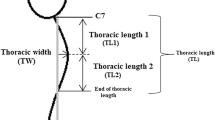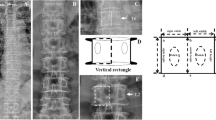Abstract
Summary
C7WD is a practical, valid, and reliable measure that could clearly indicate a risk of hyperkyphosis and vertebral fracture in the elderly. The findings might be particularly of use in regions difficult to access radiology or for the determination of those who need further invasive radiologic examination and therapy.
Purpose
To investigate psychometric properties of the 7th cervical vertebra wall distance (C7WD) to determine the risk of thoracic hyperkyphosis and spinal fracture, as compared to a standard radiologic Cobb’s method.
Methods
Community-dwelling elderly (n = 104), aged at least 60 years with occiput-wall distance > 0 cm, were assessed for their C7WD using rulers and a specially developed tool for an accurate perpendicular distance from C7 to the wall: infrared-gun kyphosis wall distance tool (IG-KypDisT). The first 15 participants were also involved in the reliability tests by a healthcare professional, village health volunteer, and caregiver. Within 7 days, all participants were at a hospital to complete a lateral plain radiograph (Cobb’s method).
Results
Outcomes of C7WD had excellent correlation to the Cobb angles (r = 0.87 for rulers and r = 0.92 for IG-KypDisT), with excellent reliability when used by all three raters (ICC3,3 = 0.85–0.99). The C7WD of at least 7.5 and 9.5 cm had the best diagnostic properties to determine the risk of thoracic hyperkyphosis and vertebral fracture, respectively.
Conclusion
C7WD is valid and reliable with good diagnostic properties for thoracic hyperkyphosis and vertebral fracture. The findings confirm the use of C7WD using traditional ruler-based method as a practical tool to screen and monitor severity of thoracic hyperkyphosis in clinics and communities. In addition, the measurement using the IG-KypDisT provided accurate data that can be saved for further analysis; it is therefore suggested for research settings. The findings would promote the standardization of hyperkyphosis measurements in various settings.



Similar content being viewed by others
References
Kado DM, Prenovost K, Crandall C (2007) Narrative review: hyperkyphosis in older persons. Ann Intern Med 147:330–338
Katzman WB, Wanek L, Shepherd JA, Sellmeyer DE (2010) Age-related hyperkyphosis: its causes, consequences, and management. J Orthop Sports Phys Ther 40:352–360
Bouxsein ML, Melton LJ 3rd, Riggs BL et al (2006) Age- and sex-specific differences in the factor of risk for vertebral fracture: a population-based study using QCT. J Bone Miner Res 21:1475–1482
Keller TS, Harrison DE, Colloca CJ, Harrison DD, Janik TJ (2003) Prediction of osteoporotic spinal deformity. Spine 28:455–462
Kado DM, Browner WS, Palermo L, Nevitt MC, Genant HK, Cummings SR (1999) Vertebral fractures and mortality in older women: a prospective study. Study of osteoporotic fractures research group. Arch Intern Med 159:1215–1220
Siminoski K, Warshawski RS, Jen H, Lee KC (2011) The accuracy of clinical kyphosis examination for detection of thoracic vertebral fractures: comparison of direct and indirect kyphosis measures. J Musculoskelet Neuronal Interact 11:249–256
Tran TH, Wing D, Davis A, Bergstrom J, Schousboe JT, Nichols JF, Kado DM (2016) Correlations among four measures of thoracic hyperkyphosis in older adults. Osteoporos Int 27:1255–1259
Kauffman KS, Myers DH (1997) The changing role of village health volunteers in northeast Thailand: an ethnographic field study. Int J Nurs Stud 34:249–255
Amatachaya P, Wongsa S, Sooknuan T, Thaweewannakij T, Laophosri M, Manimanakorn N, Amatachaya S (2016) Validity and reliability of a thoracic kyphotic assessment tool measuring distance of the seventh cervical vertebra from the wall. Hong Kong Physiother J 35:30–36
Antonelli-Incalzi R, Pedone C, Cesari M, Di Iorio A, Bandinelli S, Ferrucci L (2007) Relationship between the occiput-wall distance and physical performance in the elderly: a cross sectional study. Aging Clin Exp Res 19:207–212
Balzini L, Vannucchi L, Benvenuti F, Benucci M, Monni M, Cappozzo A, Stanhope SJ (2003) Clinical characteristics of flexed posture in elderly women. J Am Geriatr Soc 51:1419–1426
Wongsa S, Amatachaya P, Saengsuwan J, Amatachaya S (2012) Concurrent validity of occiput-wall distance to measure kyphosis in communities. J Clin Trials 2:1–3
Wongsa S, Amatachaya S (2014) Kyphosis assessment. J Med Tech Phy Ther 26:105–116
Suwannarat P, Wattanapan P, Wiyanad A, Chokphukiao P, Wilaichit S, Amatachaya S (2017) Reliability of novice physiotherapists for measuring Cobb angle using a digital method. Hong Kong Physiother J 37:34–38
Azadinia F, Kamyab M, Behtash H, Saleh Ganjavian M, Javaheri MR (2014) The validity and reliability of noninvasive methods for measuring kyphosis. J Spinal Disord Tech 27:E212–E218
Mukaka MM (2012) Statistics corner: a guide to appropriate use of correlation coefficient in medical research. Malawi Med J 24(3):69–71
Walter SD, Eliasziw M, Donner A (1998) Sample size and optimal designs for reliability studies. Stat Med 17:101–110
Briggs AM,Wrigley TV, Tully EA, Adams PE, Greig AM, Bennell KL (2007) Radiographic measures of thoracic hyperkyphosis in osteoporosis: Cobb and vertebral centroid angles. Skelet Radiol 36:761–767
Teixeira FA, Carvalho GA (2007) Reliability and validity of thoracic hyperkyphosis measurements using flexicurve method. Rev Bras Fisioter 11:173–137
Wu W, Liang J, Du Y et al (2014) Reliability and reproducibility analysis of the Cobb angle and assessing sagittal plane by computer-assisted and manual measurement tools. BMC Musculoskelet Disord 15:33
Martinez-Abadias N (2005) Evolution patterns of the human skull. A quantitative genetic analysis of craniofacial phenotypic variation. University de Barcelona
Di Bari M, Chiarlone M, Matteuzzi D et al (2004) Thoracic hyperkyphosis and ventilatory dysfunction in unselected older persons: an epidemiological study in Dicomano, Italy. J Am Geriatr Soc 52:909–915
van der Jagt-Willems HC, de Groot MH, van Campen JP, Lamoth CJ, Lems WF (2015) Associations between vertebral fractures, increased thoracic kyphosis, a flexed posture and falls in older adults: a prospective cohort study. BMC Geriatr 15:34
Schafer RC (1983) Body alignment, posture, and gait, 2nd edn. Williams & Wilkins, Baltimore
Atkinson G, Nevill AM (1998) Statistical methods for assessing measurement error (reliability) in variables relevant to sports medicine. Sports Med 26:217–238
Acknowledgements
The researchers sincerely thank Miss Arpassanan Wiyanad and Miss Pakwipa Chokphukiao for their contribution in data collection. In addition, the researchers are thankful for contribution and funding support from the Research and Researcher for Industries or RRi (Grant No. 5770I0039), Faculty of Engineering and Architecture, Rajamangala University of Technology Isan, Nakhon Ratchasima, and the Improvement of Physical Performance and Quality of Life (IPQ) Research Group, Khon Kaen University, Thailand.
Author information
Authors and Affiliations
Corresponding authors
Ethics declarations
All procedures of the study were in accordance with the standards of the Ethics Committee for Human Research (HE581446). Eligible participants completed a written informed consent form before participation in this study.
Conflicts of interest
None.
Rights and permissions
About this article
Cite this article
Suwannarat, P., Amatachaya, P., Sooknuan, T. et al. Hyperkyphotic measures using distance from the wall: validity, reliability, and distance from the wall to indicate the risk for thoracic hyperkyphosis and vertebral fracture. Arch Osteoporos 13, 25 (2018). https://doi.org/10.1007/s11657-018-0433-9
Received:
Accepted:
Published:
DOI: https://doi.org/10.1007/s11657-018-0433-9




